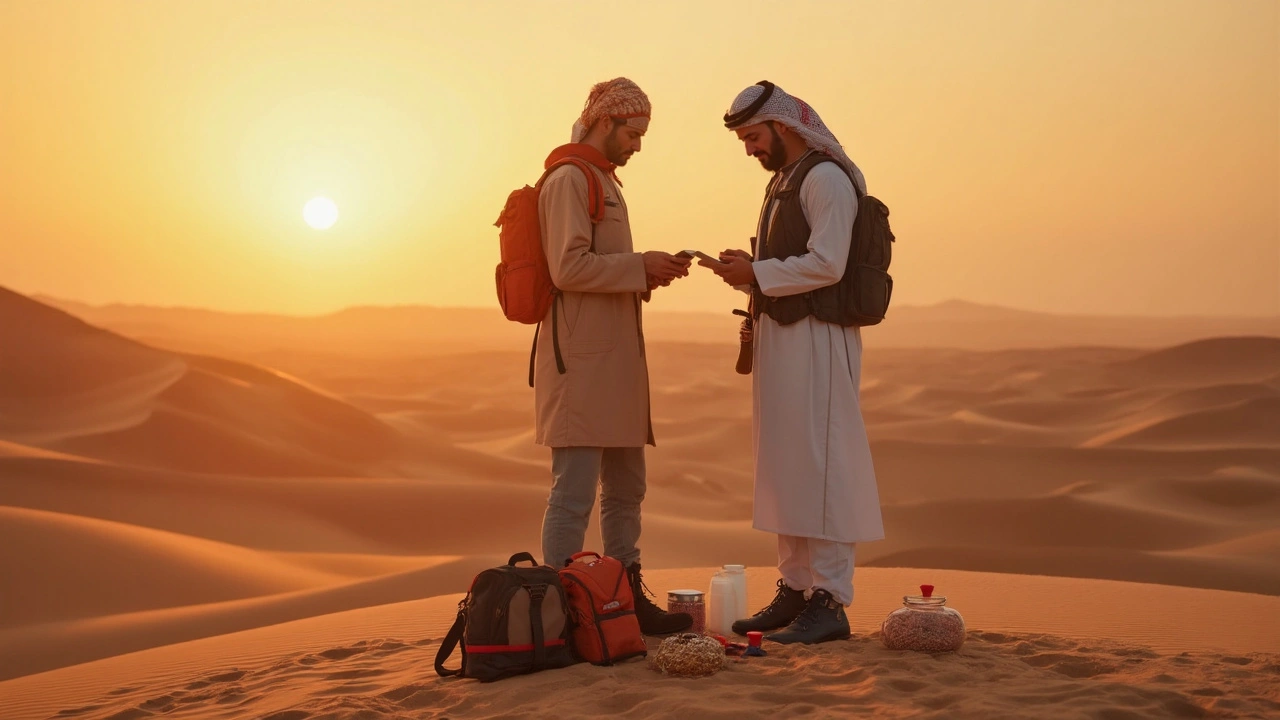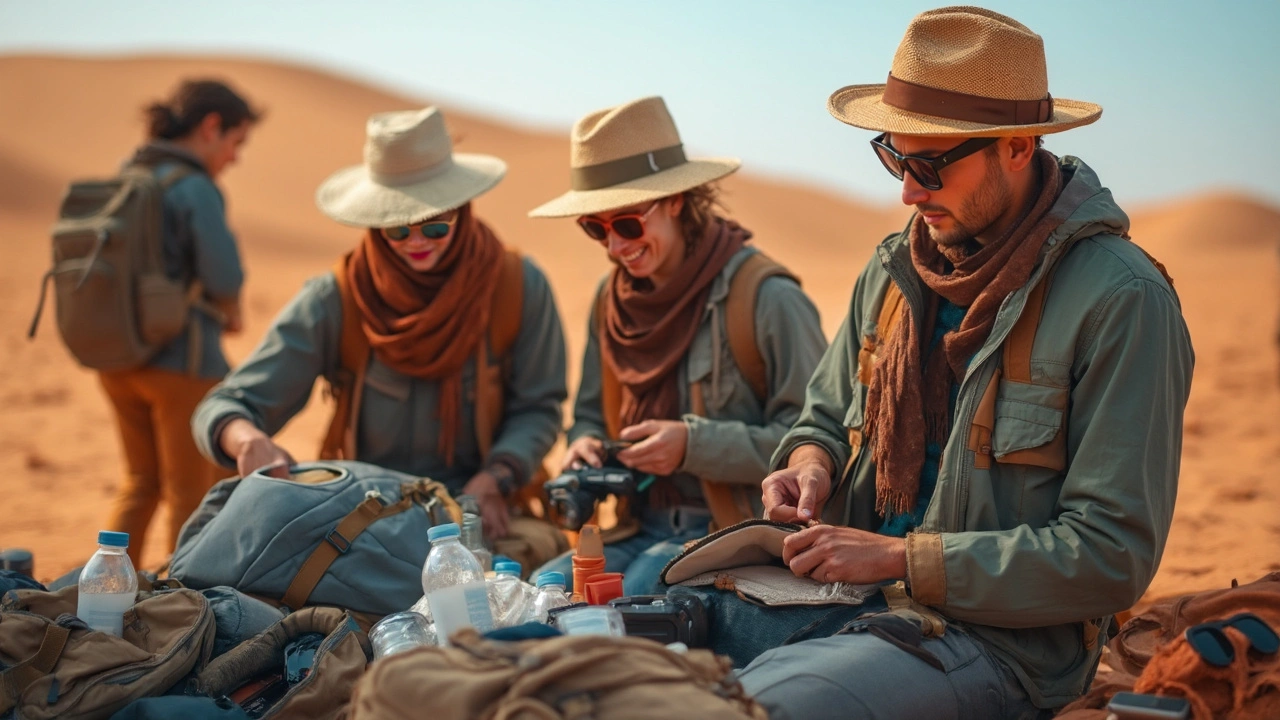Forget the overstuffed suitcase—packing for a desert safari is all about picking the right gear and leaving the fluff at home. The desert doesn’t care if you look cool in photos; it cares if you’re prepared for blazing heat, chilly nights, and enough sand to turn your socks into sandpaper. Miss the basics, and even a sunrise over golden dunes can turn into an uncomfortable slog.
You’ll need to think smart about your clothes. Light, long-sleeved tops keep you cooler than a tank top, and they protect your skin from both sunburn and biting insects. Avoid dark colors—black soaks up heat faster than a seatbelt in July. And don’t forget a proper hat; wide-brimmed is your friend out here, because baseball caps barely shade your face.
Hydration is the lifeline. Always pack more water than you think you’ll need. Seriously—two liters might sound like a lot until you’re halfway through and dry as a bone. Sunscreen isn’t just a bonus, it’s non-negotiable. Go high SPF, water-resistant, and reapply every time you stop for photos, or you’ll regret it by sunset.
- Quick Checklist of Desert Safari Essentials
- Direct Answer: The Must-Haves
- Detailed Packing Guide for the Desert
- Pro Tips for a Hassle-Free Safari
Quick Checklist of Desert Safari Essentials
Don’t want to forget something crucial for your desert safari essentials list? Here’s the no-nonsense checklist I wish I’d had before heading out into the dunes. These aren’t “nice to have” items—they’re the gear that’ll keep you comfortable, safe, and ready for anything. Double-check before you zip up your bag.
- Light, long-sleeved shirts and pants: Protects against the sun and bugs. Avoid black or dark blue—they heat up fast.
- Wide-brimmed hat: Caps are useless against the desert sun. Wide brims keep your neck and face shaded.
- Sunscreen (SPF 30+): Water-resistant for real staying power. Reapply every two hours or after sweating.
- Sunglasses: Polarized lenses cut glare and actually let you see past the blinding sand.
- Refillable water bottles or hydration bladders: Bring at least 2 liters per person. Thirst creeps up on you in dry heat.
- Comfortable, closed-toe shoes: Sandals mean sand everywhere. Stick to hiking shoes or sneakers with ventilation.
- Neck gaiter or scarf: Perfect for keeping sand and sun off your face when the wind picks up.
- Lightweight jacket or fleece: Even if it’s baking hot at noon, deserts cool off fast once the sun drops.
- Small backpack or daypack: For water, snacks, your camera, and stuff you want handy during the drive.
- Camera or smartphone (dust-proof case optional): Desert landscapes are unreal, so you’ll want to snap plenty of photos—but sand can wreck a phone in seconds if you’re not careful.
- Power bank: Phone batteries die faster in extreme heat or cold. A charged power bank will save you when you need it most.
- Basic first aid kit: Pack plasters, antiseptic wipes, and painkillers. Small scrapes and blisters can balloon into bigger problems quickly out there.
Bonus: If you wear contacts, bring spares and your glasses. Gritty winds and lenses are a nightmare combo.
| Activity | Min. Water Needed |
|---|---|
| Short Safari (3-4 hours) | 2 liters per person |
| Full-Day Adventure | 3-4 liters per person |
| With Kids | Add 0.5 liters per kid |
Cut this list, and you’ll risk a rough time. Stick to it, and your adventure will feel a whole lot more enjoyable.
Direct Answer: The Must-Haves
Not sure what you really need for a desert safari essentials list? The honest answer: if it doesn’t protect you, hydrate you, or keep you safe, leave it behind. Here’s the no-nonsense lineup to nail every desert adventure without wishing you’d packed better.
- Water Supply: Two liters per person, minimum. If you’re going deep into the dunes or it’s mid-summer, bring even more. Hydration packs work great because you can sip as you go.
- Sun Protection: Broad-spectrum SPF 30+ sunscreen, a wide-brim hat (not just a regular cap), and a pair of legit UV-blocking sunglasses. The desert sun bounces off the sand and burns from every angle.
- Light, Long Clothing: Think loose, long-sleeved shirts and lightweight pants. They keep you cooler and shield skin better than shorts or tanks. Cotton or technical fabrics that wick sweat are best.
- Closed Shoes: Open sandals sound tempting but sand will get everywhere and there are thorns. Go with trainers or hiking shoes; socks are a must to avoid blisters.
- Scarf or Buff: You’ll want one for unexpected sand gusts. Pull it over your mouth and nose when the wind picks up.
- Flashlight or Headlamp: If you’re staying till dusk or camping overnight, don’t rely on your phone. Headlamps keep your hands free.
- Basic First-Aid: Blister plasters, antiseptic wipes, and something for stomach upsets—change in water or food can throw you off.
- Power Pack: Battery drains fast in extreme heat, especially if you’re snapping photos or using GPS. Bring a backup power bank for your phone or camera.
- Trash Bag: Stick to Leave No Trace—pack out everything, even snack wrappers.
Here’s a simple breakdown to keep things clear:
| Item | Why You Need It |
|---|---|
| Water (min. 2L) | Dehydration risk is real |
| Sun Protection | Burns can sneak up fast |
| Long-Sleeved Clothing | Keeps you cooler and blocks sun |
| Closed Shoes | Protects feet from sand, thorns, critters |
| Scarf/Buff | Stops sand from choking you on windy days |
| First-Aid Kit | For quick fixes—blisters, cuts, stomach |
| Power Bank | Keeps devices alive |
Skip designer sunglasses and heavy jackets—you’ll just carry dead weight. Focus on these desert safari essentials and your trip will be far safer (and way more comfortable).

Detailed Packing Guide for the Desert
The right stuff in your bag can make the line between an epic desert safari and a total headache. Here’s a breakdown so you can focus on the adventure, not on what you left behind.
- Clothing: Go for loose, lightweight, long-sleeved shirts and pants. Cotton or moisture-wicking fabric is best. Long sleeves keep your arms safe from the sun and bug bites. Skip shorts and tank tops, no matter how hot it is—you want protection, not a sunburn.
- Hat and Sunglasses: Pack a wide-brim hat, not just a baseball cap, for real shade. Good UV-blocking sunglasses are your best friend—a cheap pair just won’t cut it with all that glare.
- Footwear: Cover those toes. Sturdy sneakers or hiking boots work best, and don’t mess with open sandals—you’ll end up dumping sand out every few steps.
- Water and Hydration: Bring at least two liters of water per person per day. A reusable insulated bottle helps keep water cool way longer than plastic bottles.
- Sunscreen: High SPF (at least SPF 50), water-resistant. Put some in every bag or pocket—you’ll want to reapply, especially after sweating or wiping your face.
- Lip Balm and Moisturizer: Dry lips and skin are the norm out here. Small tubes take zero space but make a huge difference.
- Personal Items: Baby wipes for quick cleanups. Hand sanitizer because soap is a desert luxury. Any personal medicine—keep it in a sealed bag so it stays sand-free.
- Lightweight Backpack: A small daypack keeps snacks, water, and your gear handy. Go for zippered pockets to keep the sand out.
- Camera or Smartphone: Desert light is unbeatable for photos—just keep devices in a zip bag when not using, or sand will invade every corner.
- Headlamp or Flashlight: Power cuts and dark nights are common. Evenings get pitch-black fast, and your phone’s flashlight won’t go far.
- Scarf or Bandana: These are life-savers when wind whips up sand or you need to shield your face or neck.
- Spare Socks: Changing into fresh socks after a day in sweaty boots makes you feel human again. Go for moisture-wicking if you can.
Here’s a quick stat for perspective: average daytime highs in deserts like the UAE can hit 45°C (113°F), while nights drop below 15°C (59°F). Layers aren’t just for comfort—they’re survival.
| Item | Why You Need It |
|---|---|
| Wide-brim Hat | Shields your face, neck, and ears from harsh sun |
| 2+ Liters of Water | Dehydration is the #1 risk on a desert safari |
| High-SPF Sunscreen | Protects exposed skin from serious burn |
| Closed-Toe Shoes | Keeps feet safe from hot sand and sharp rocks |
| Light Jacket | Desert nights can get unexpectedly cold |
It’s normal to overthink packing, but stick to this proven desert safari essentials list and you’ll be covered for most surprises. If you remember nothing else, pack more water, something to cover your head, and sunscreen. The rest just makes the adventure a whole lot easier.
Pro Tips for a Hassle-Free Safari
Want to enjoy your desert safari essentials without hiccups? Trust me, the right tricks can turn a hot, sandy ordeal into the highlight of your trip.
- Test Your Gear Before You Go: Break in those hiking boots at home. The desert is not the place for surprise blisters.
- Pack Baby Wipes: Sand sticks to everything—baby wipes are a lifesaver for a quick clean-up before meals or after a sweaty hike.
- Charge Up, Power Down: Portable chargers can keep phones and cameras running, but only use electronics if you must. Bring an extra battery – battery drain doubles in extreme heat.
- Keep Snacks Handy: High-energy bars or unsalted nuts can be game changers when you’re running low on steam and far from camp.
- Stash Sand-Proof Bags: Zip-lock or dry bags keep phones, IDs, and cash safe. Fine desert sand can fry electronics faster than you can say malfunction.
- Respect the Wildlife: Remember, scorpions and snakes won’t bother you if you watch where you step, never reach into crevices, and always check shoes in the morning.
Here’s a quick glance at some common problems and how to dodge them:
| Problem | Simple Solution |
|---|---|
| Sunburn | Wear high SPF sunscreen and reapply every two hours |
| Getting lost | Use a GPS tracker and never separate from the group |
| Heat exhaustion | Drink water regularly, take shade breaks |
| Sand in gear | Use sealed bags and keep openings shut tight |
If you’re worried about what’s worth spending a bit more on, experts say don’t skimp on footwear or head protection. The American Hiking Society puts it bluntly:
"Sturdy shoes and sun hats are your best defense in any desert environment—don’t underestimate the elements."
Last tip—make sure your travel insurance covers desert activities. Some policies exclude off-road or adventure tours. You don’t want to find out the hard way that your coverage stops as soon as your tire hits the sand.
Lock in these what to pack tips and you’ll be one of the folks swapping desert adventure stories instead of rescue tales.







